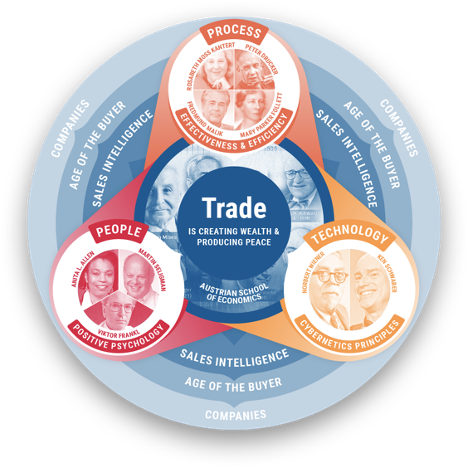Continuing our series on complexity, let’s now examine how we harness the vast complexity involved with today’s technology.
One factor differentiating Pipeliner CRM from our competitors—especially high-end systems such as Salesforce, Microsoft Dynamics, and Oracle NetSuite—is that we have taken the incredible complexity involved with a CRM application and made it simple for the user. To accomplish this, we have utilized cybernetic principles, as illustrated in the technology portion of the Pipeliner Philosophy Wheel.

You can see in the technology segment of the wheel that we have implemented cybernetic principles.
Simplification
One of the functions of cybernetics is the simplifying of complex processes, which we utilize in Pipeliner. One of our major missions is to reduce complexity in the lives of our users. I learned computing technology within the mindset of Steve Jobs, and therefore adopted his philosophy: “It takes a lot of hard work to make something simple, to truly understand the underlying challenges and come up with elegant solutions.” This simplification is most evident with Pipeliner’s totally visual user interface (UI).
Because of Pipeliner’s powerful but simple appearance, it may seem that development was easy—but as stated by Steve Jobs, simplicity is only accomplished through much hard work. A CRM solution is quite complex. Multiple functions, such as accounts, contacts, leads and opportunities, are combined with email communication, activities, fields and forms, report engines, and more. It took us many years to bring a product to fruition that is easy, simple, and quick to adopt, which was always our primary goal.
An example of a technology that has not been made simple is cryptocurrency, which is why I haven’t become involved with it. Everything about cryptocurrency—buying, selling, exchanging—is terribly complicated.
Demonstrated Preferences
By simplifying our CRM processes, we make it possible for a salesperson—or any CRM user—to demonstrate their preferences.
It is demonstrated preferences that change the world, that actually get things done, as opposed to simply expressed preferences. Thinking, all by itself, accomplishes nothing. It is an active demonstration of that thinking that will produce results. When it comes to sales, our application makes itself adaptable to a salesperson’s specific mindset—their demonstrated preferences.
Here’s a practical example: Let’s say one of your preferences is to create a growing pipeline. What is the most important factor for doing so? It is that new leads are coming in and are converting to opportunities. If your conversion rate for leads to opportunities is 25 percent, and you have a quota of $200,000 per month, you should maintain approximately $800,000 worth of leads in the pipeline. Because of Pipeliner’s visual UI, you will always know where you stand. Pipeliner will flexibly and efficiently allow this demonstrated preference to be accomplished.
Core Principles
Further to simplifying complexity, three core principles apply in the simplification of sales in general.
1. Multiple management layers are outmoded and are no longer necessary. Why? Because today’s systems are completely transparent—Pipeliner being a prime example. The function of multiple management layers in the past has been collecting and analyzing data from the levels below. But today, Pipeliner serves this function, and top management can readily see a rep’s pipeline creation, feeds, calls, activities, lead creation, lead conversion, and closing of opportunities. There is no need for additional management layers.
2. We are steering salespeople toward self-responsibility and have deeply embedded this concept within Pipeliner. Within Pipeliner, the user and their management see the same data. The user sees exactly what their manager sees. Because of this, any salesperson will remain productive, knowing that non-production will immediately show up in CRM and be visible to management. Pipeliner’s CRM data also informs a salesperson of the actions they need to take to make quota and continue to achieve their sales goals.
We don’t go so far as to provide sales reps with the data of other reps—they only see their own data, but it is the same data as management is viewing.
Transparent access to data is something that is totally missing today. For examples outside of sales, we have yet to learn what really happened with COVID, and we’re not being given access to the Nord Stream Pipeline sabotage investigation.
Allowing salespeople to view the same data as management steers salespeople toward self-responsibility. What does self-responsibility mean? That a salesperson should be optimistic about what they can achieve, they should set their own goals, and they should be engaged.
Responsibility is the flip side of freedom. Contrary to some beliefs, freedom does not mean people can do whatever they want. It’s about how a person creates their freedom, is self-focused and open to reach the goal that they have, in their responsibility, set.
3. We provide individuality to a user. We allow a tremendous amount of flexibility in the adoption of the Pipeliner user interface. For example, if a salesperson is more inclined to use a spreadsheet view of deals, they can utilize Pipeliner’s List View. If they’re more visually inclined, they can utilize the Pipeline View. They can use the Map View if they wish to view the locations of leads, accounts, contacts and opportunities.
We believe that part of a salesperson’s individuality is a gameful approach to sales—viewing sales as a game. This is another reason we made our interface easy and attractive. As proven by many of our customers, salespeople love Pipeliner because of this nature. Providing this individualization means that no one is dictating to the salesperson that “this is all you have. You’re just a machine. You do what you’re told.”
These three core principles combine to help CRM users become more self-responsible and secure because they can take control and calculate their actions. And that is a sure way to harness and control today’s complexity!






















Comments